8 min read
TurboTenant’s All-in-One Property Management Platform
All-in-One Property Management, Built for Landlords Whether you operate dozens of rental properties or just one, all the work that goes into...

As a landlord, maintaining and updating your property is essential to stay competitive and attract potential renters. Plus, renovating a rental property will help it increase in value and serve as a great passive income opportunity!
From adding a fresh coat of paint to updating the kitchen countertops, these 16 tricks for renovating a rental property will help you increase your rental income for your side hustle.
Whether you are a new landlord or a seasoned investor, calculating your return on a potential real estate investment is a necessity, we’ve got a free tool that will give you all the data you need to decide if a property is right for you.
Whether you are a new landlord or a seasoned investor, calculating your return on a potential real estate investment is a necessity, we’ve got a free tool that will give you all the data you need to decide if a property is right for you.
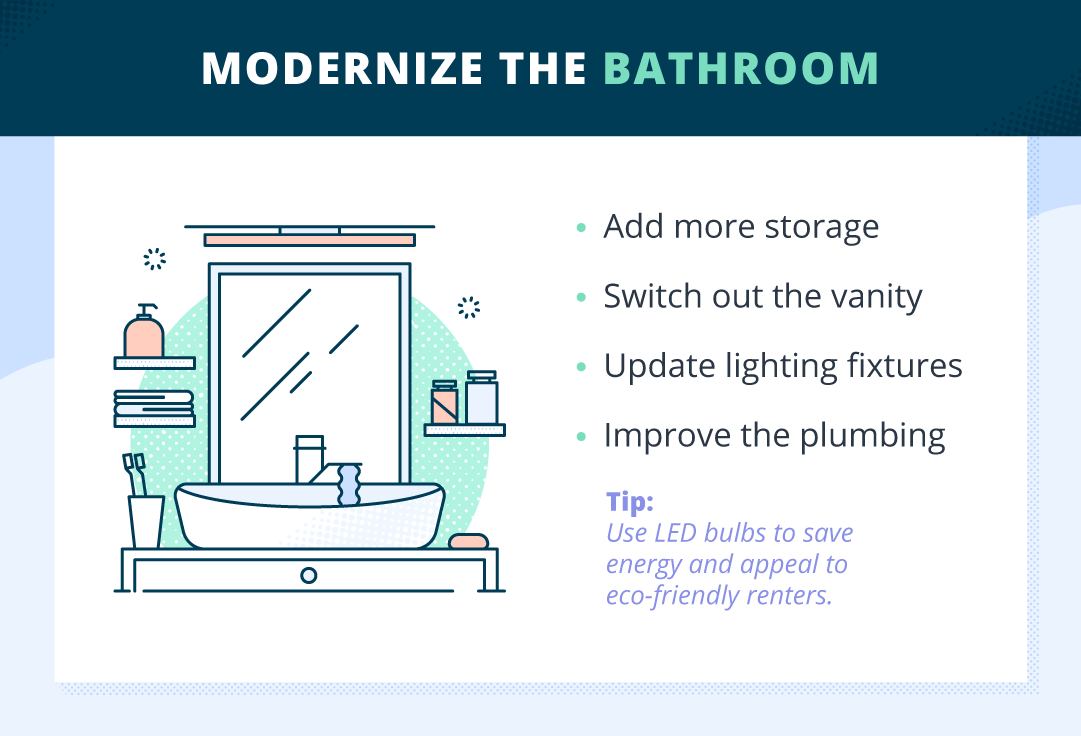
Having an up-to-date bathroom with modern touches is something that tenants look for. Here are some easy upgrades to implement in any bathroom.
A bathroom seems to be the one place in the home that never has enough storage space — this is a highly sought after feature for renters. Thankfully, landlords can easily add more storage in order to make the most of a small bathroom.
To do this, you can add wall hooks to hang towels or robes, or put in a towel rack. If the bathroom doesn’t already have one, install a shelf above the toilet or on the back of the door to store linens and other toiletries. To further increase storage, install a medicine cabinet above the sink.
Approximate cost: $100 – $300
Tip: Stack multiple shelves on top of each other for maximum storage opportunity.
It may be time to update the vanity in the bathroom. Whether a fresh coat of paint is added to it or it is replaced completely, changing the vanity is a quick and easy way to transform the space’s look and give it the modern touch it needs.
Approximate cost: $300 – $2,000
Tip: Some bathroom vanities, such as wall-mounted vanities, may require new plumbing work to install.
Outdated light fixtures in a bathroom do nothing to enhance the home’s appeal. It’s easy to update the lighting in a bathroom without needing an electrician — a pain-free and low-cost option. Some simple options include spray painting the fixture itself, installing wireless fixtures, or adding fabric shades over the bulbs.
Approximate cost: $100 – $400
Tip: Switch out traditional bulbs for LED ones to save energy and appeal to eco-friendly renters.
Over time, bathroom fixtures like toilets, sinks, and faucets can become crusty and outdated. An easy fix is to swap these out for a more modern and refined look. Consider installing finishes like brushed nickel, bronze, or copper.
New fixtures will easily add a sophisticated touch to a bathroom and will wow potential renters. When installing, ensure that all of the new fixtures match for a cohesive look.
Approximate cost: $250 – $1,500
Tip: No matter the condition of your plumbing, it’s a good idea to replace them every 10 years.
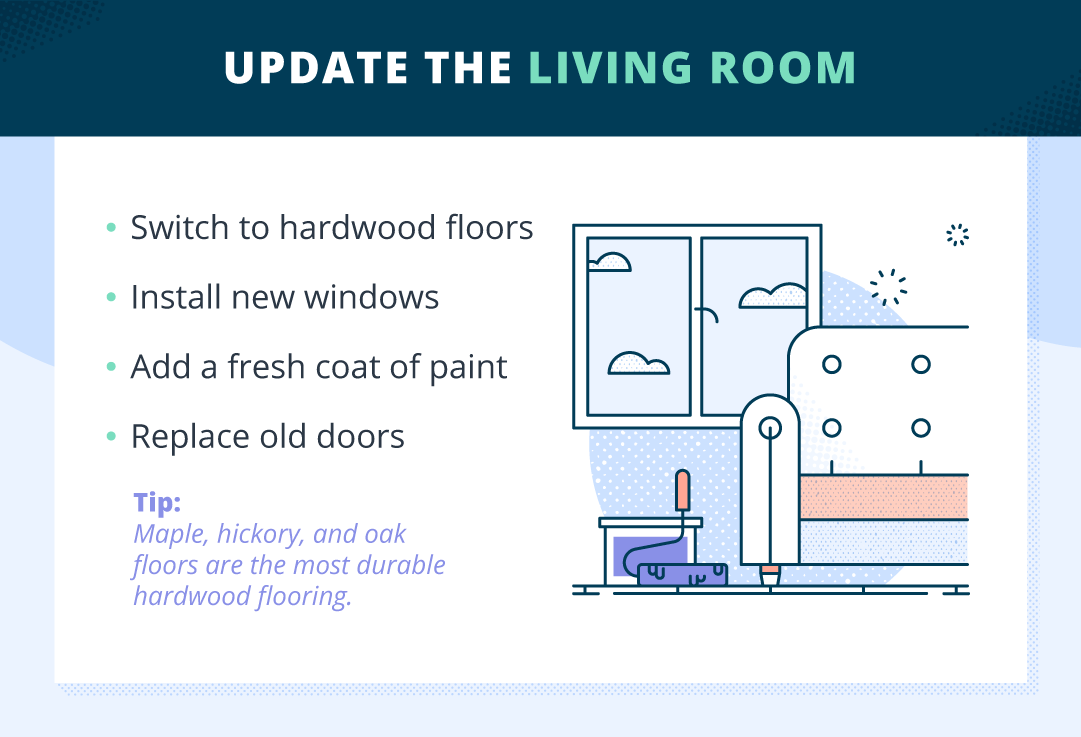
The living room is where tenants spend a lot of time. Ensure the space is updated with these simple renovation ideas.
If the property has carpeted flooring, consider updating to a more upscale material, such as laminate, stone, tile, or hardwood, to boost its value. Switching out old carpet is not only more appealing in terms of appearance, but it also makes it easier for both landlords and tenants to clean and maintain.
In some states, it’s mandatory for landlords to replace the carpet in rental units after a certain number of years. Check your state laws first.
Approximate cost: $3,000 – $10,000
Tip: If you decide to install hardwood flooring, maple, hickory, and oak are the most durable wood species, ideal for units with heavy foot traffic and pets.
Based on the property’s age, the windows may be in need of replacement. The windows may need to be swapped out once they show signs of moisture build up between the panes, air is coming through when they’re closed, or the frames are beginning to decay.
The most common type of window fixture is the double-hung window. Not only do they help a property feel light and bright, but they are also important for temperature control. Additional upgrades that landlords can make include installing windows with blinds or blackout shades.
Approximate cost: $150 – $650
Tip: Install double-pane windows for better insulation and reduced outside noise.
Nothing changes the look and feel of a living room more than a fresh coat of paint — not to mention, it has the highest return on investment for small budgets. When ordering paint, ensure you order in bulk to get it at a lower price, especially if you have more than one unit that needs an upgrade.
Landlords should opt to paint their properties in a neutral color, such as white or tan to appeal to the largest population of potential tenants.
Approximate cost: $100 – $1,000
Tip: Choose a low- or zero-VOC paint to ensure your indoor air quality is not impacted.
Doors tend to show the most wear and tear in rental properties, usually because they’re in highly trafficked areas and can be easily affected by the climate. Luckily, doors are an easy swap when upgrading a property. New doors can change the look of a space dramatically and won’t break the bank in the process.
Approximate cost: $500 – $5,000
Tip: For a cheaper installation, ensure the new door fits the existing door frame.
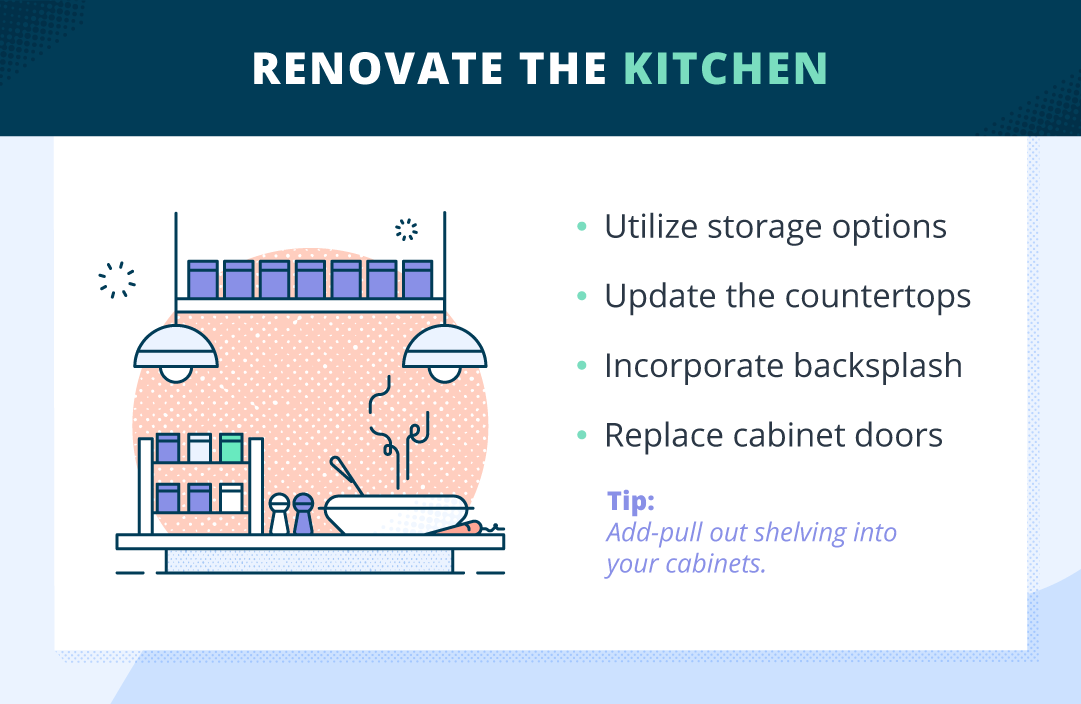
When renovating a rent property, keep in mind the kitchen is where people spend their time cooking and sharing meals with loved ones. Be sure to renovate the kitchen to wow potential renters.
Not only is storage important for a bathroom, but it’s equally valuable for the kitchen area. Add more space by installing additional shelving inside the pantry, replacing your cabinets with ones that reach the ceiling, or adding stylish railings for hanging storage.
Approximate cost: $50 – $800
Tip: Add pull-out shelving inside the cabinets to make kitchen items more accessible.
Although higher-end countertops may be more costly, cheaper and out-dated countertops may cost you more in the long run since they’re more prone to staining and disrepair. As a landlord, installing new countertops in natural materials like granite, quartz, marble, or slate will instantly polish the kitchen and appeal to more potential tenants.
Approximate cost: $1,800 – $4,000
Tip: For a more budget-friendly option, stick to ceramic tile or stained concrete countertops.
Backsplashes can add value to a property quickly. Choose something simple like white subway tiles — these can brighten up any kitchen. For a more affordable alternative, opt for stick-on vinyl tiles to allow for more flexibility.
Approximate cost: $150 – $600
Tip: To keep the kitchen looking timeless, choose a backsplash in neutral colors, and avoid trendy ones such as turquoise.
Replacing an entire cabinet fixture can be costly. Instead, just replace the cabinet doors with new ones. Doors made of higher-quality solid wood are a good option if you’re looking to make your upgrades go further, and they can easily be painted to match the cabinet fixture.
To elevate the look even further, add some sophisticated hinges and knobs as the final touch.
Approximate cost: $1,000 – $3,000
Tip: Measure the cabinet fixture before purchasing new doors.
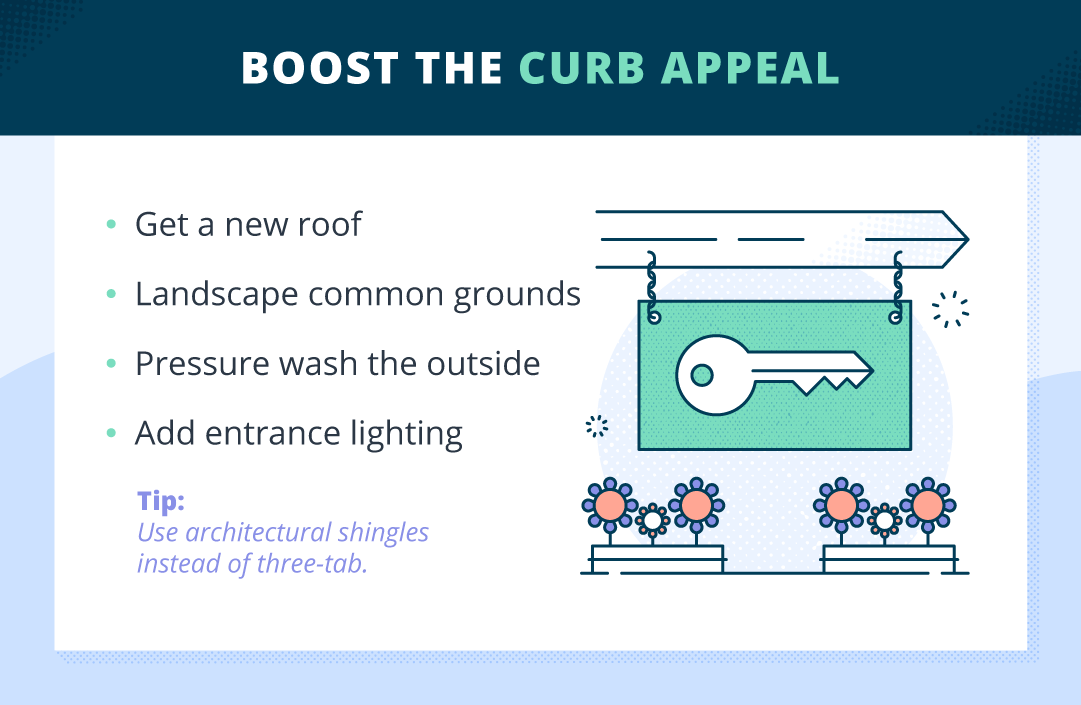
For many tenants, the outside of a property is almost as important as the interior. Make a good impression by adding some curb appeal with these transformative exterior updates.
After about 15 years, a roof needs to be updated. If this is put off, it could lead to more costly repairs due to damage from severe weather and leaks. As a landlord, have an inspector check out the roof regularly.
Not only does a new roof look great from the outside, but it protects all the renovations that have been done within the property.
Approximate cost: $5,000 – 10,000
Tip: Architectural shingles are thicker and will last longer than three-tab shingles.
Spruce up the outside of the property with some landscaping updates, without needing to hire anyone. To do this, add some new shrubs or flowers, take care of any overgrown weeds, mow the lawn, or trim any trees.
Approximate cost: $100 – $500
Tip: Incorporate tall plants into the landscaping to add extra privacy to your property.
Properly cleaning the outside of a property can instantly make a difference and give it the deep clean it needs. This can be done by hiring someone or doing it yourself using a long pressure washing wand.
Approximate cost: $100 – $300
Tip: When using a pressure washer, avoid spraying the windows.
Entrance lighting is one of the first things potential renters will see when looking at a property. If your property currently has outdated and dusty lighting, making the upgrade will give the front entrance of your property the special touch it needs.
Not only will it look great, but it will add value to your property. Install a new pendant light or chandelier over the front door for a unique touch.
Approximate cost: $1,000 – $3,000
Tip: Lighting also provides additional security for a property, so ensure all entry points are also well lit.
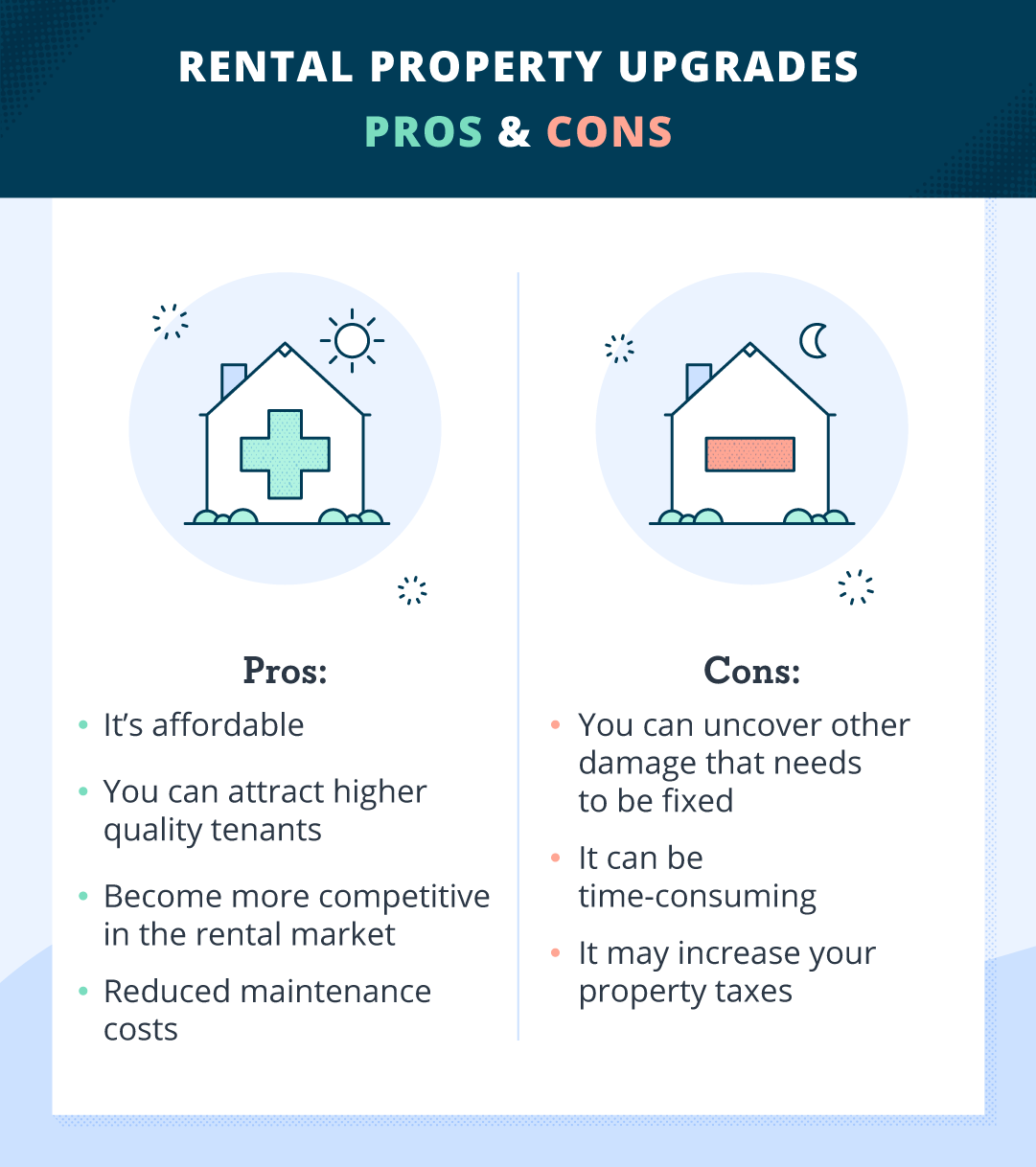
When renovating a rental property, there are certain factors to consider before any changes are made:
Affordable: If done correctly, renovations can be affordable and have a high return on investment.
Reduce maintenance and operational costs: Updating old appliances can save you money in the long term by reducing the need for repairs. Additionally, modern appliances are usually more energy-efficient, which saves you money on energy costs.
Attract higher-quality tenants: If you renovate your property, you’ll likely be able to raise the rent price, attracting higher-earning tenants. Quality tenants that can afford higher rent are more likely to take care of the updates you’ve made to the property and pay rent on time.
Compete with other rental properties: Making modern updates to your property will keep you up-to-date and able to stay competitive in the rental market. You’ll be able to attract a larger group of potential renters if you introduce tenant-friendly and sought-after updates into the property.
Uncovering surprises: Sometimes, renovating properties, especially those that are dated, can reveal some unexpected updates that also need to be made. For example, there may be utilities that are no longer up to date or hidden damage to something that wasn’t visible before the renovation.
Time-consuming: Some renovations can take a long time to complete, such as adding a new roof or flooring. Make sure to consider the timeline before you start renovating.
Higher property taxes: Renovations may make the price of your property increase in value, but it could also result in you having to pay higher property taxes. Be aware of your tax situation and how it may change after the renovations are completed.
Renovating a rental property to boost your rental income doesn’t have to hurt your wallet! These simple changes add up, making your property more desirable for higher rent and more attractive to potential tenants. If you’re a landlord looking to fill an apartment, visit our rental application and tenant screening services to help find the perfect tenants.
8 min read
All-in-One Property Management, Built for Landlords Whether you operate dozens of rental properties or just one, all the work that goes into...
9 min read
Juggling uncooperative tenants, costly repairs, and looming vacancies is a fast-track recipe for burnout. And in the worst states to be a...
12 min read
Wondering how to become a landlord? Our guide outlines what you need to know, from how to buy rental property to tenant...
Join the 750,000+ independent landlords who rely on TurboTenant to create welcoming rental experiences.
No tricks or trials to worry about. So what’s the harm? Try it today!
TurboTenant, Inc., © 2025
Created in Sunny Colorado